
Courgette: sowing, planting, growing in the vegetable garden
Contents
Courgette in a nutshell
- Zucchini is a vegetable that thrives in the sun, in rich, loose, deep, and cool soil.
- It has an elongated or round shape, with a range of colours from pale to dark green or bright yellow; the variety choice is vast and original!
- Sowing is done in April, in buckets in a warm place, or directly in open ground in May. The young plants are installed in the garden after mid-May.
- Maintenance during cultivation is child’s play; zucchini is easy and productive. But keep an eye out for powdery mildew!
- Zucchini is low in calories and packed with minerals and vitamins; moreover, it is versatile in the kitchen.
A word from our expert
Courgette is a fruit-vegetable from the large family of Cucurbitaceae which includes many vegetable plants such as cucumbers, melons, squashes, etc. There is a beautiful diversity of courgette varieties. Among the best-known are the ‘Verte de Milan’, a vigorous variety that produces elongated, dark green fruits; the ‘Coucourzelle’ with its tasty fruits; the ‘Gold Rush’, which delights us with its golden yellow colour; and I cannot forget the ‘De Nice à fruits ronds’, ideal for stuffing. I miss the varieties with necks and the “marrow squash” type, which are now difficult to find!
Growing courgettes is very simple, even for beginner gardeners. It is ideally done in full sun and in loose, rich organic soil, deep enough to remain cool on the surface in summer. A summer mulch is, in this regard, highly recommended to maintain this coolness. It will also help keep the courgettes less in direct contact with the soil, which can lead to rot on the fruits.
Sowing courgettes is possible and recommended for all amateur gardeners. It is economical and just as simple as growing courgettes in general. Sowing is preferably done in buckets from April to obtain plants ready to be planted in the garden in May. It can also be done in place, starting in May.
If growing courgettes holds no secrets for you, why not try making your own seeds? Discover all my tips at the end of this article! Undoubtedly fun, this practice contributes to your self-sufficiency in seeds and to sharing among gardeners, so don’t hesitate for a second!
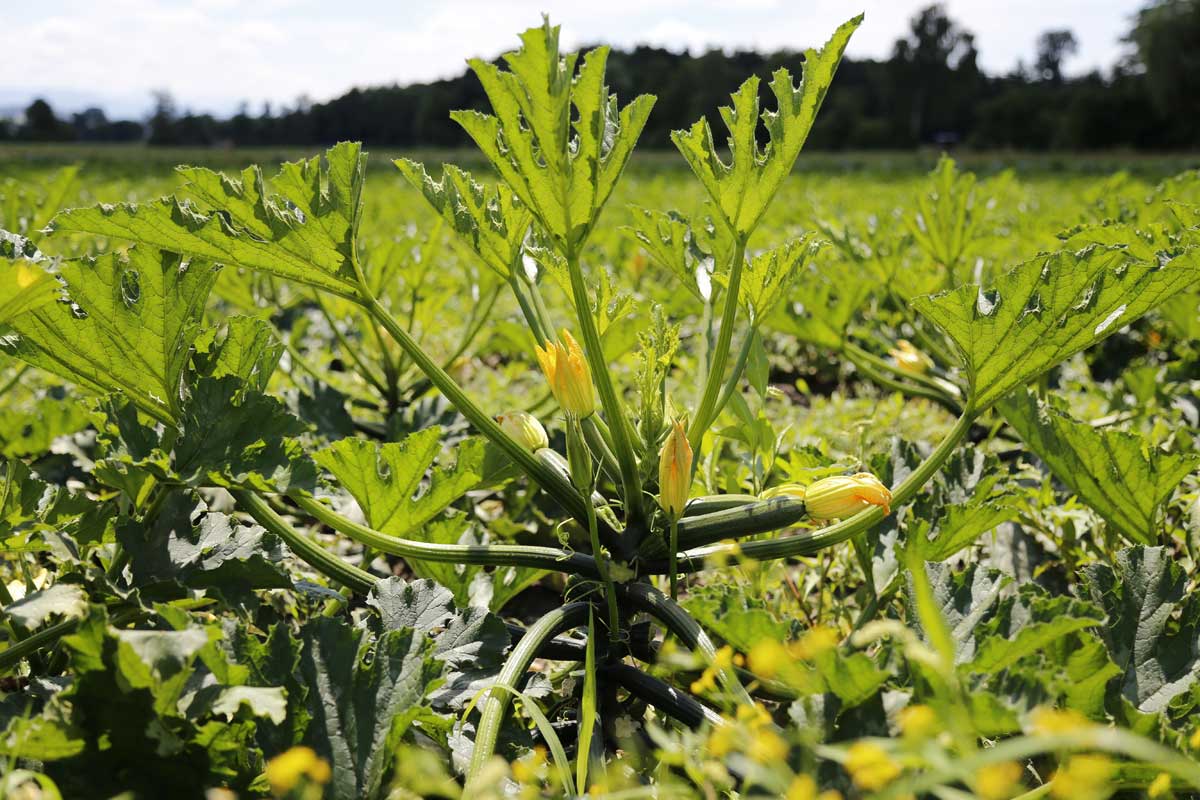
Growing courgettes in the open field
Description and Botany
Botanical data
- Latin name Cucurbita pepo var. pepo
- Family Cucurbitaceae
- Common name Courgette
- Flowering Annual
- Height 4 to 6 m
- Exposure Sun
- Soil type rich, loose, deep, cool in summer
- Hardiness 0°C
Like all plants of the genus Cucurbita, courgette is native to the Americas, however the first selections of cultivated courgettes only appeared in the 18th century in Italy. Unlike squashes, courgette is consumed at a juvenile stage, before the skin hardens and before the seeds form in the fruit. It is therefore harvested young, not mature.
Courgette – Cucurbita pepo var. pepo – is a fruit-vegetable of the family Cucurbitaceae, which includes many edible species cultivated by humans, such as squashes, melons, cucumbers, and watermelons. The pepo species includes both courgettes and also pattypans, pumpkins, and other oil squashes.
We find in courgette, as in most pepo, certain common characteristics: their habit is bushy, the leaves are distinctly lobed and prickly, as are the petioles and stems. The flowering of courgette is monoecious, bearing male flowers and female flowers on the same plant, in different locations. The female flowers bear the fruits, while the male flowers produce pollen. The blooming of a flower lasts only one day. Pollen is transported by pollinating insects such as bees and bumblebees, and the pollination is referred to as entomophilous. Additionally, courgette is allogamous, meaning it promotes cross fertilization with other varieties of the species or other plants of the same species.
A well-fertilized courgette flower will produce a fruit whose shape is characteristic of the variety; the most common shape is elongated and straight, more or less ribbed. It can also be flattened at the ends and present a round shape like the ‘Ronde de Nice’, with a neck or even club-shaped, like marrow squash. The colours range from light green to dark green, more or less marbled, to yellow and white. Courgette seeds are slightly rounded and grey to white in colour.
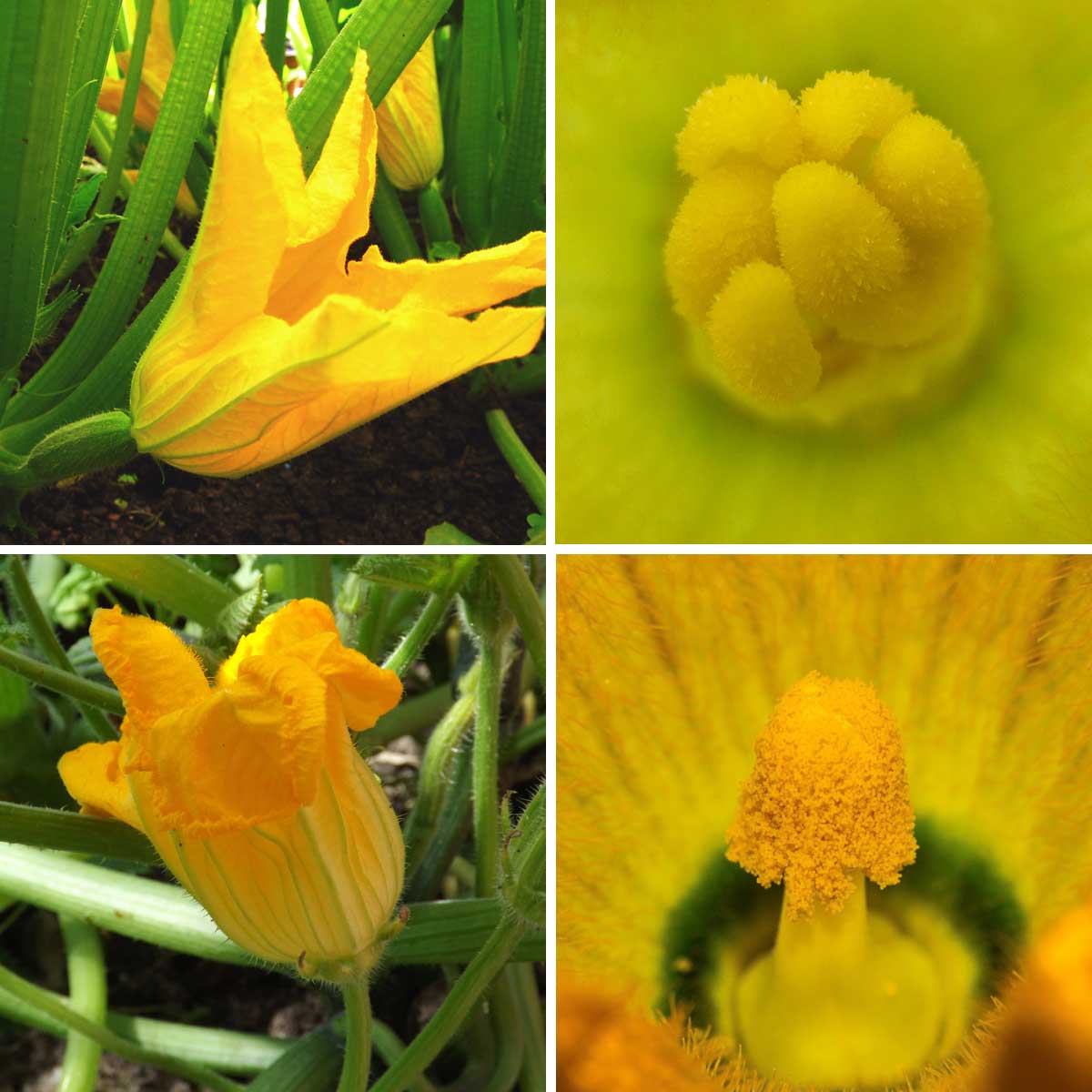
Above: Female flower in its entirety and close-up of the stigma of the pistil. Below: Male flower in its entirety, the peduncle is clearly visible and close-up of the stamen, where pollen grains can be observed.
Read also
Powdery mildew or white diseaseCourgette varieties
The choice of varieties is based on their shape and culinary use, colour, earliness, hardiness, and of course, flavour. Here is a selection of our tried-and-true favourites!
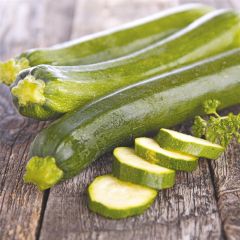
Courgette Alberello di Sarzana - Ferme de Sainte Marthe Seeds
- Flowering time June to August
- Height at maturity 50 cm
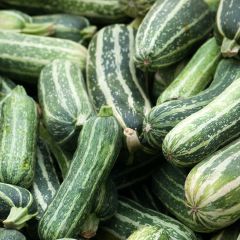
Non-trailing Zucchini - Vilmorin seeds - Cucurbita pepo
- Flowering time June to August
- Height at maturity 50 cm
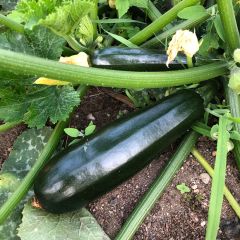
Zucchini Black Beauty - Cucurbita pepo
- Flowering time June to August
- Height at maturity 50 cm
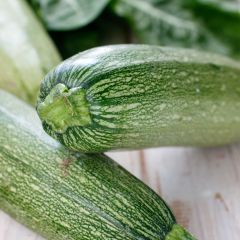
Zucchini Grisette de Provence - Cucurbita pepo
- Flowering time August, September
- Height at maturity 50 cm
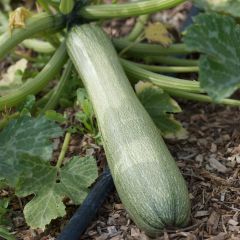
Courgette Genovese - Ferme de Sainte Marthe Seeds
- Flowering time June to August
- Height at maturity 50 cm
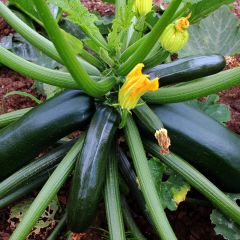
Courgette Verte Noire Maraîchère - Vilmorin Seeds
- Flowering time June to August
- Height at maturity 50 cm
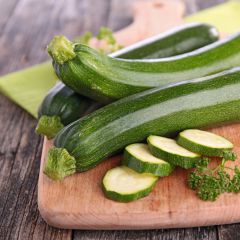
Zucchini Firenze - Cucurbita pepo
- Flowering time June to August
- Height at maturity 45 cm
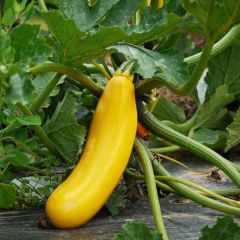
Yellow Courgette - Ferme de Sainte Marthe Seeds
- Flowering time June to August
- Height at maturity 50 cm
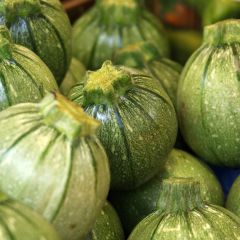
Courgette Nice à fruit rond - Vilmorin Seeds
- Flowering time June to August
- Height at maturity 50 cm
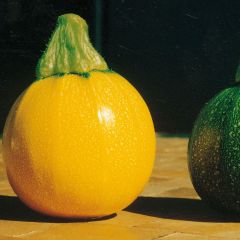
Zucchini Jaune One Ball - Cucurbita pepo
- Flowering time July to September
- Height at maturity 60 cm
Discover other Courgette seeds
View all →Available in 0 sizes
Available in 1 sizes
Available in 1 sizes
Available in 1 sizes
Available in 1 sizes
Available in 1 sizes
Available in 1 sizes
Available in 1 sizes
Available in 1 sizes
Sowing courgette
Where and When to Sow Courgettes?
Sowing courgettes is preferably done in a bucket. However, it can also be done directly in open ground. Courgettes are among the greedy vegetables that thrive in rich, organic, loose, and deep soil. It is advisable to prepare the bed by adding compost at a rate of 3 to 4 kg per m2.
Courgettes are sown:
- from mid-April to mid-May in a warm environment, indoors or in a heated shelter
- from mid-May to mid-July directly in open ground.
How to Sow Courgettes?
You can prepare young plants to be planted in the vegetable garden once all risk of frost has passed or sow directly in place.
Preparing Young Plants:
- Fill pots or buckets with a good potting mix,
- Place two seeds per pot (flat) at a depth of about 2 cm and cover with potting mix,
- Water for the first time using the spout of the watering can
Keep warm and in the light (on a windowsill), at around 20°C, and maintain the substrate moist but not waterlogged until germination, which usually takes between 5 and 8 days. When the young plants are well-developed, thin them out, keeping only the strongest seedling.
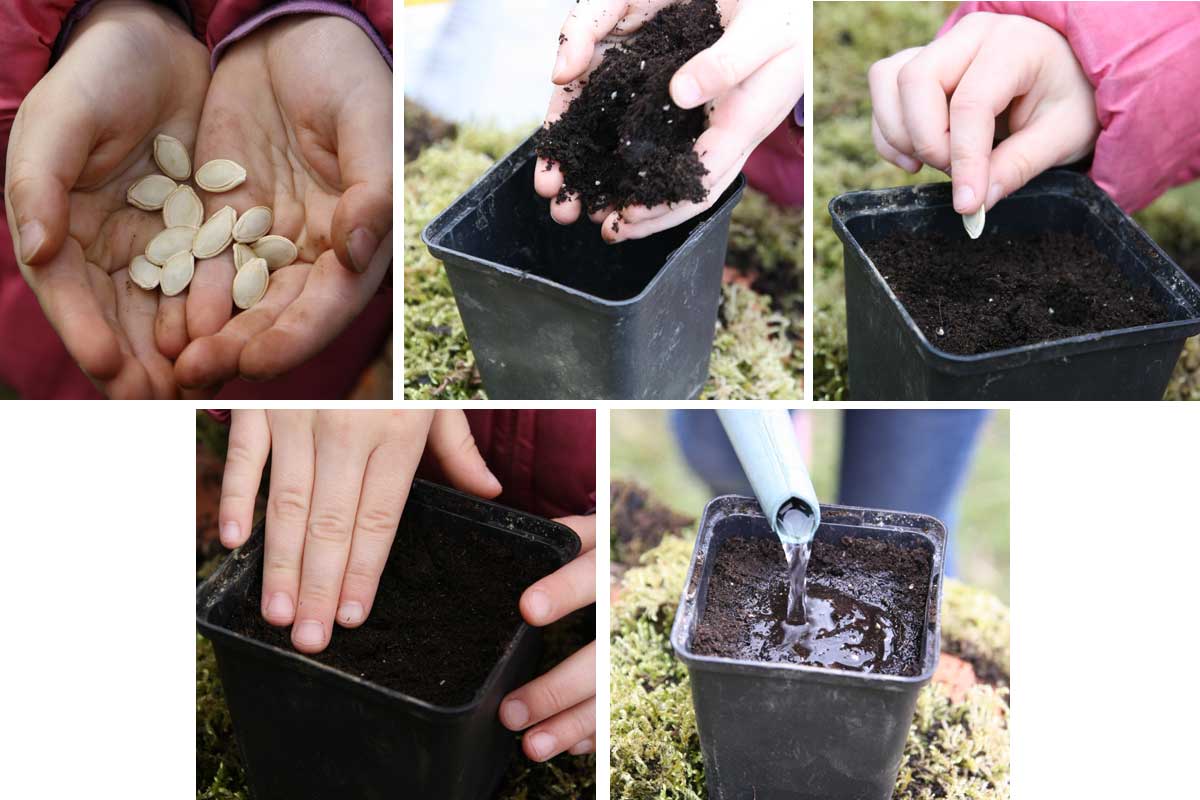 Sowing courgette seeds in a bucket
Sowing courgette seeds in a bucket
Sowing in Open Ground, Directly in Place:
Sowing is done in clusters, in weeded and loosened soil, spacing the plants one metre apart in all directions:
- Dig holes 2 to 3 cm deep,
- Place three seeds per hole and cover with fine soil and lightly compact,
- Water for the first time, with a light rain to avoid displacing the seeds,
- Keep the soil moist until germination.
After germination, when the young plants are well-developed, thin them out to keep only the best plant from each cluster.
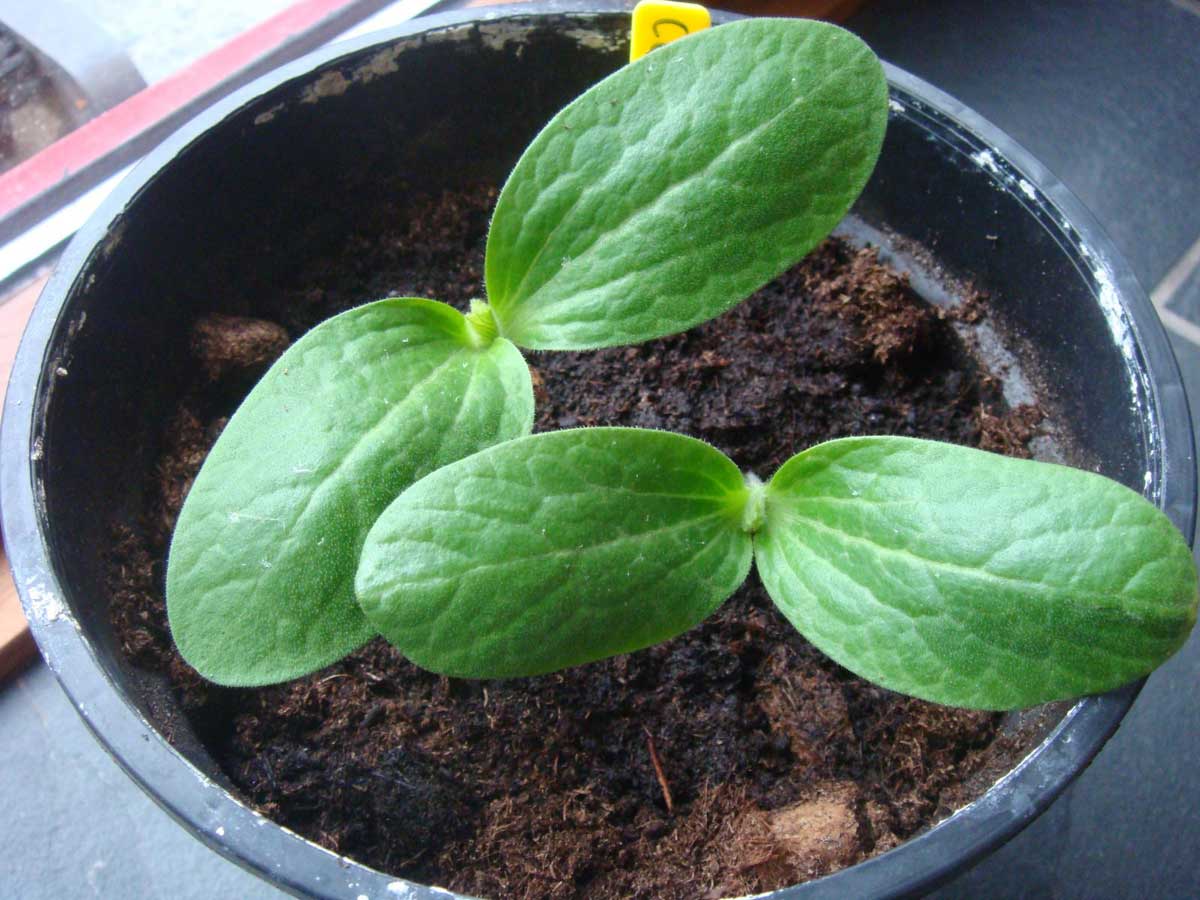 Young courgette seedlings. To thin out… or transplant!
Young courgette seedlings. To thin out… or transplant!
Planting courgettes: when and how?
When to plant courgettes?
Courgette planting takes place from May, preferably after the Ice Saints, in regions most sensitive to cold. In the South, they can be planted as early as mid-April, monitoring the weather and possibly protecting them from the last frosts with a cover. It is possible to continue planting until July.
The planting distances are 1 m between each young plant and 1.3 m between the ranks. Note that these distances can be reduced depending on the varieties: “trailing” varieties spread more than “non-trailing” ones.
How to plant courgettes?
Courgettes require a well-manured soil, previously enriched with an addition of compost or well-rotted manure of 3 kg per m2.
To plant your courgettes:
- dig a hole corresponding to the volume of the root ball,
- place the root ball and cover it with soil,
- firm the soil and water to keep it moist,
- to facilitate recovery, water regularly at the base.
→ Discover our tips for growing courgettes in pots
Growing, watering, and companion planting of courgette
Three well-maintained young plants of courgettes allow for a regular harvest of courgettes for a family of four. If your diet is predominantly vegetarian… or if you really love courgettes, don’t hesitate to plant more!
Regarding cultivation, it’s important to know that:
- harvesting the fruits encourages the production of a new flowering.
- Placing a slate or tile under the fruit to protect it is a good tip if the soil tends to retain moisture.
- Courgettes prefer cool soils in summer, remember to mulch around the young plants.
- Avoid watering the leaves or flowers, instead water at soil level using the spout of the watering can.
- Due to its significant growth, it is much more practical to grow courgettes alone; however, it is possible to grow them near basil, onion, and beans.
→ Pascale explains why courgettes do not produce.
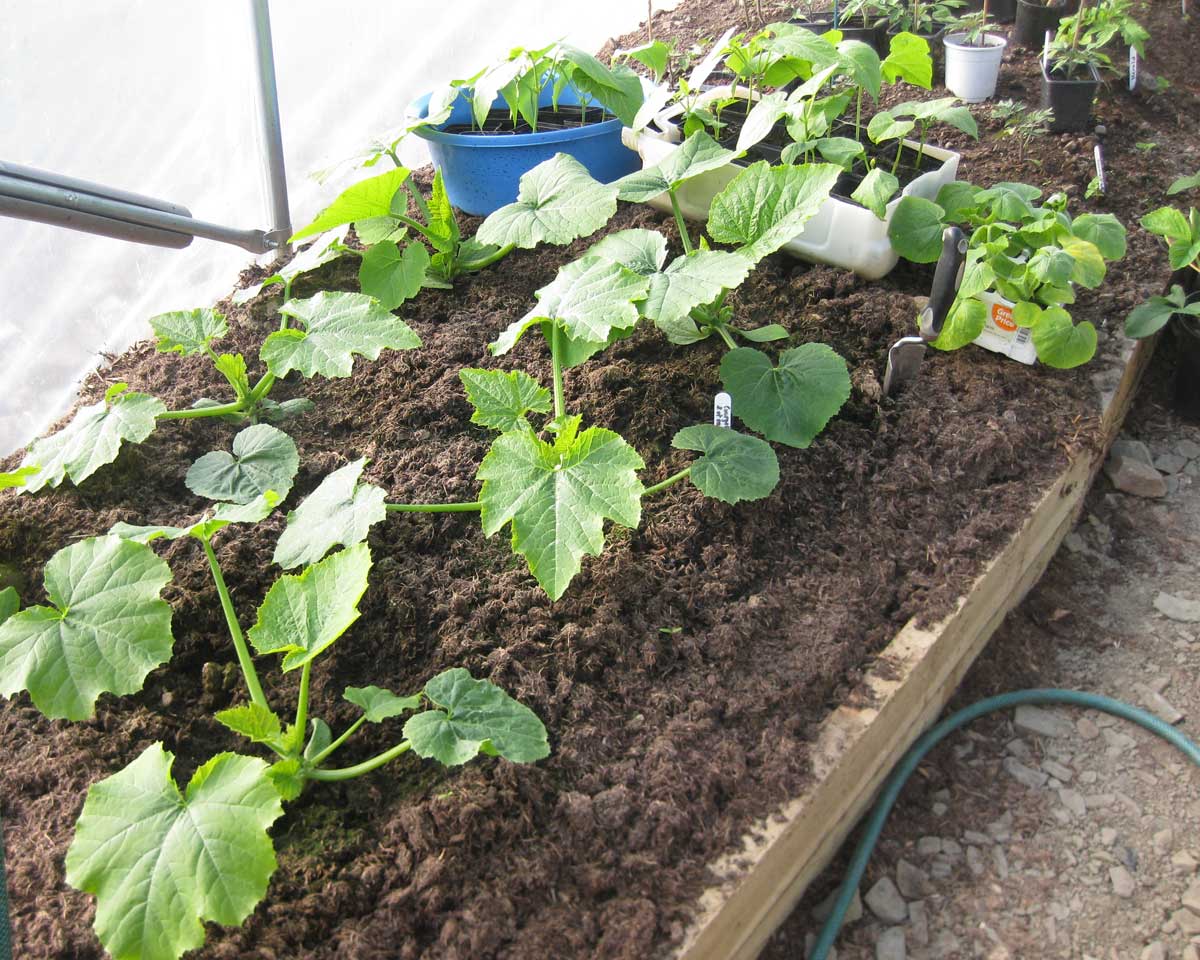
Courgette cultivation in a greenhouse, ideal for harvesting earlier in the season
Common diseases
Powdery Mildew on Courgette
Powdery mildew is a cryptogamic disease (caused by a fungus) that manifests as white, powdery spots on the leaves, which eventually dry out, leading to reduced production and the plant may ultimately die. This disease appears when conditions are warm and humid. 27°C is the ideal temperature for the fungus to develop. Powdery mildew is common at the end of the season, so it is unnecessary to act at that time; however, when the plants are in full production, intervention is required. Here are some preventive and curative tips to apply:
- space the plants well during planting: 1 metre between each plant is advisable as they need air to allow the leaves to dry quickly in case of rain.
- Avoid fertilisers that are too rich in nitrogen; prefer a well-balanced compost!
- A keen eye will allow you to remove the first outbreaks by cutting off the affected leaves.
- The natural “magic potion” consists of diluted skimmed milk at a ratio of 1/10th. Use it to spray on the affected leaves. Repeat this operation regularly to curb the spread of the fungus.
- In biodynamics, it is common to spray horsetail decoction to limit the arrival of the fungus.
→ Read also: Diseases and Pests of Squashes and Courgettes
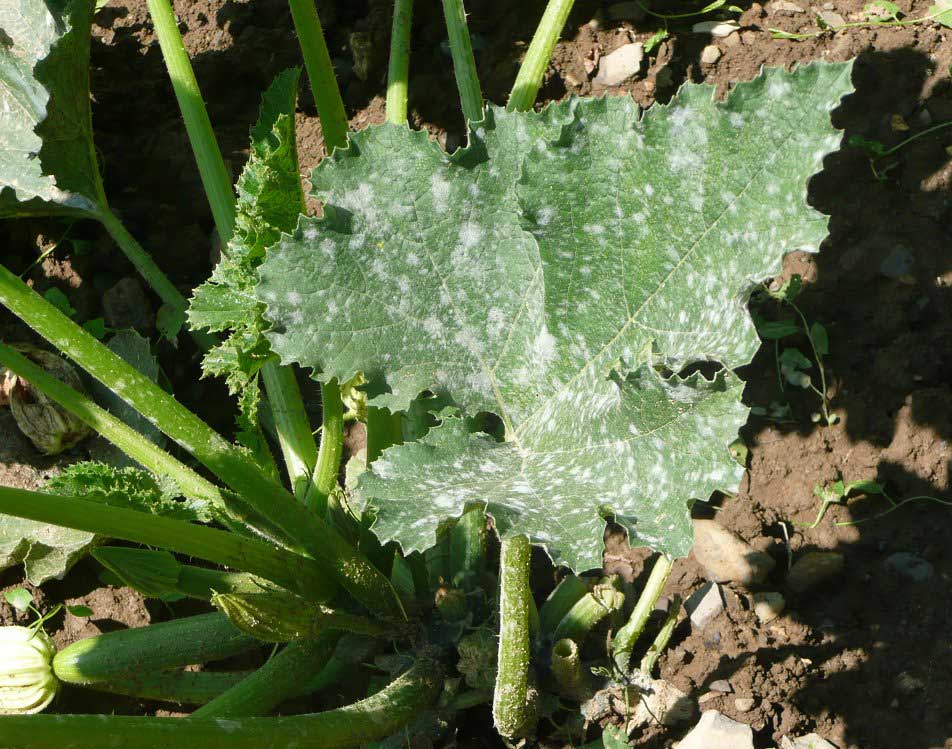
Powdery mildew on courgette leaf. It is also visible on the petiole.
Harvesting and storing courgettes
Young courgettes are much more flavoursome and should be consumed quickly after harvest, still crunchy. To harvest, it is preferable to cut the peduncle cleanly with a knife or pruning shear rather than twisting the courgette, as this tearing is a gateway to diseases.
Courgettes harvested later, after returning from holidays, can be consumed, but they will need to be emptied and peeled (the skin hardens). Their taste is, however, much less interesting than that of young courgettes, and they will be useful for soups and ratatouille.
Young courgettes can be stored for a few days in the bottom of the refrigerator. “Old” courgettes can be kept for a few weeks. Courgettes can also be stored cut into pieces and then frozen, or placed in jars and sterilised.

Harvesting courgettes
→ Also discover Ingrid’s tips on lacto-fermentation
Uses and nutritional benefits
Courgettes are used in a variety of dishes: grated raw, or cooked in ratatouille, sautéed, tagliatelle, or of course stuffed – round varieties or large hollowed courgettes are ideal for this purpose. Less commonly, male and female courgette flowers are edible and are usually stuffed or cooked in fritters. In the case of the female flower, the pistil is removed, and the mini courgette is left attached to the flower.
Discover how to make courgette flower fritters?
Nutritionally, courgette is rich in minerals (potassium, magnesium, calcium) and vitamins, particularly provitamin A, vitamin B, and C. It also contains fibre and is very low in calories, making it an excellent weight-loss vegetable.
Making your courgette seeds
As we have seen previously, courgette is entomophilous and cross-pollinating, promoting cross fertilization with other varieties of the species or other plants of the same species, and this pollination occurs through the intervention of pollinating insects. Manual pollination is therefore recommended to ensure the preservation of the characteristics of the desired variety.
Manual Pollination of Courgettes
It is first recommended to grow several plants of the same variety, at least six plants. A selection of the most beautiful plants, conforming to the description of the variety and of good precocity, are kept and used for seed production.
- The day before pollination, identify the female flowers to be pollinated and the male flowers that will provide the pollen; at this stage, their corolla is cream in colour. If you are unsure, observe the development of the flowers over several days to identify the stage just before the flowers open. Remember, the courgette flower only opens for one day!
- Using clothespins, tie up the male and female flowers to prevent them from opening and to keep insects from pollinating them.
- The next morning, pick the tied male flowers from one plant to pollinate another plant of the same variety.
- Cut the corolla of the male flower to expose the stamens that carry the pollen.
- Remove the clothespin from the female flower and gently open the corolla.
- Gently spread the pollen from two to three male flowers onto the stigma (pistil) of the female flower.
- Re-tie the corolla of the female flower with a clothespin.
- Clearly mark the pollinated flowers using stakes, for example.
The pollinated courgettes should be harvested when mature, that is, when the peduncle becomes dry and the skin of the courgette changes colour and hardens. Once harvested, the courgettes are kept for a month before extracting the seeds. To separate them from the flesh, soak them in water and let them dry well in a warm, ventilated place for several days before bagging them.
Learn more about manual pollination of courgette flowers
Useful resources
- Find our wide range of courgette seeds, conventional or organic!
- Check out Ingrid’s tips in this article on sowing and growing squashes and courgettes and discover her favourite varieties!
- Discover our varieties of favourite courgettes: the sure bets.
- Learn more about manual pollination of courgette flowers
- Discover the best companions for courgettes in the vegetable garden
Frequently asked questions
-
Why do my courgettes only produce flowers and no courgettes?
The most likely cause of a zucchini that is rotting is often that it has not been pollinated. The young zucchini turns yellow and then falls off the plant. - To remedy this sustainably, welcome biodiversity into your garden! - In the short term, pollinate your zucchinis yourself in the same way as explained above for seed production, being less strict about the choice of varieties; you can even cross different species of Cucurbitaceae.
-
Why are my courgettes rotting on the plant?
A courgette in direct contact with soil that retains too much moisture (predominantly clayey), during rainy spells over several days at the end of the season, often leads to courgettes rotting on the plant. Although we cannot control the weather, it is possible to place a slate under the growing fruits or to grow your young plants on woven fabric if the problem is common in your vegetable garden.
- Subscribe!
- Contents































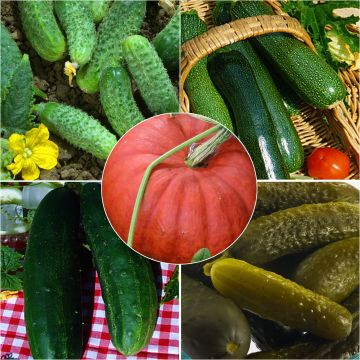
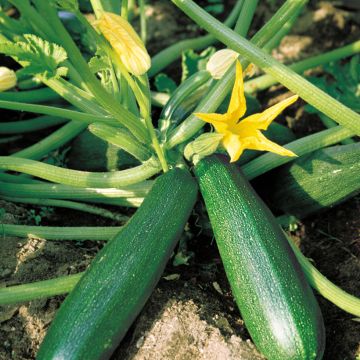
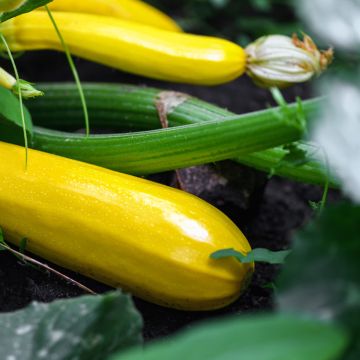

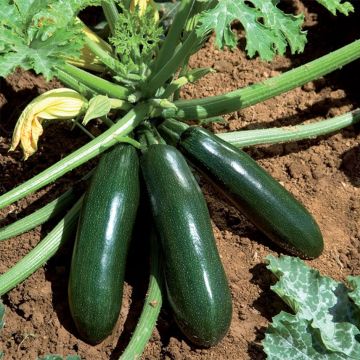

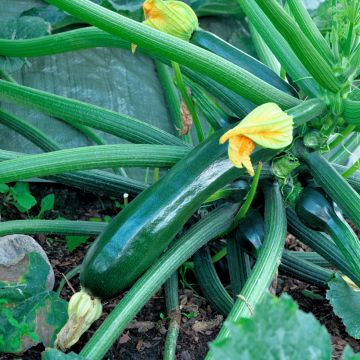
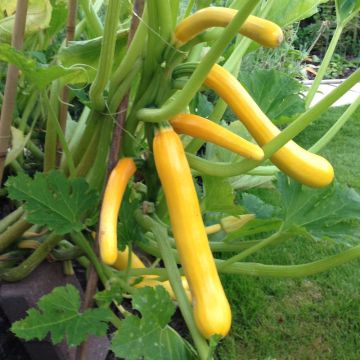
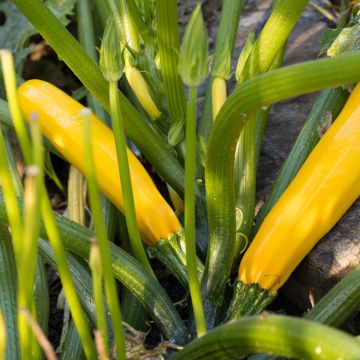
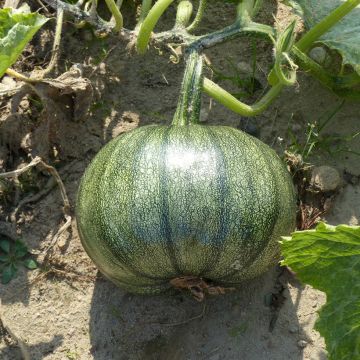
Comments